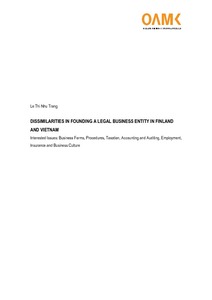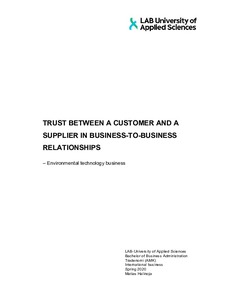Business Analysis Using Business Model Canvas: Owppin As A Case Study
KABALA, USMAN (2024)
KABALA, USMAN
2024
All rights reserved. This publication is copyrighted. You may download, display and print it for Your own personal use. Commercial use is prohibited.
Julkaisun pysyvä osoite on
https://urn.fi/URN:NBN:fi:amk-2024062023774
https://urn.fi/URN:NBN:fi:amk-2024062023774
Tiivistelmä
This work is a problem-solving thesis, it addresses the problem faced the case study company (Owppin), a company situated in Nigeria, and it is into the production of toothpick. Owppin a facing a waste challenge as the waste generated during her operation is becoming a menace to the organization. The waste is constituting an environmental hazard, and it is also causing the company unnecessary fines from the environmental agency.
The purpose of the study is to help find a lasting solution to the waste generated by the company. The study focuses on the whole organization and sees the organization as a complete system. The work uses business model canvas as enumerated by its founder Osterwalder. This framwork was considered so as to understand Owppin business processes. And. Also to help see the business at a glance.
The study also make use of the system theory to help analyse the problem with the objective of not considering only the obvious which was the waste, but the entire organization and its environment as a unit. An holistic approach (System theory) was use , which was found useful in the root cause analysis and decision making process.
The combination of business model canvas and system theory was helpful in enumerating possible solution that will not only eliminate the problem (waste generation) but also add more value proposition to the business at large.
The purpose of the study is to help find a lasting solution to the waste generated by the company. The study focuses on the whole organization and sees the organization as a complete system. The work uses business model canvas as enumerated by its founder Osterwalder. This framwork was considered so as to understand Owppin business processes. And. Also to help see the business at a glance.
The study also make use of the system theory to help analyse the problem with the objective of not considering only the obvious which was the waste, but the entire organization and its environment as a unit. An holistic approach (System theory) was use , which was found useful in the root cause analysis and decision making process.
The combination of business model canvas and system theory was helpful in enumerating possible solution that will not only eliminate the problem (waste generation) but also add more value proposition to the business at large.
Kokoelmat
Samankaltainen aineisto
Näytetään aineisto, joilla on samankaltaisia nimekkeitä, tekijöitä tai asiasanoja.
-
Creating a New Business Model by Using Business Model Innovation Tools and Identifying the Feasibility of Subscription Business as Part of the Business Model. Case: Finnish Golf Service Intermediate
Reunanen, Sanna (2020)Digitalisaatio ja yritysten strategisten painopistealueiden muuttuminen on tehnyt liiketoimintamallien systemaattisesta muuttamisesta ja tämä muutoksen johtamisesta tärkeää lähes kaikilla aloilla. Organisaatiot toimivat ... -
Dissimilarities in Founding a Legal Business Entity in Finland and Vietnam : Interested Issues: Business Forms, Procedures, Taxation, Accounting and Auditing, Employment, Insurance and Business Culture
Le, Trang (Oulun ammattikorkeakoulu, 2016)The thesis aims at providing general information in some essential legal matters of founding a business entity in Finland and Vietnam, as well as an overview on differences between the two markets. The thesis is completed ... -
Trust between a customer and a supplier in business-to-business relationships : environmental technology business
Halinoja, Matias (2020)Environmental technology suppliers represent business-to-business machinery industry which is gaining interest also in the public domain. Customers operate in variety business areas that suppliers need to adapt to. This ...



